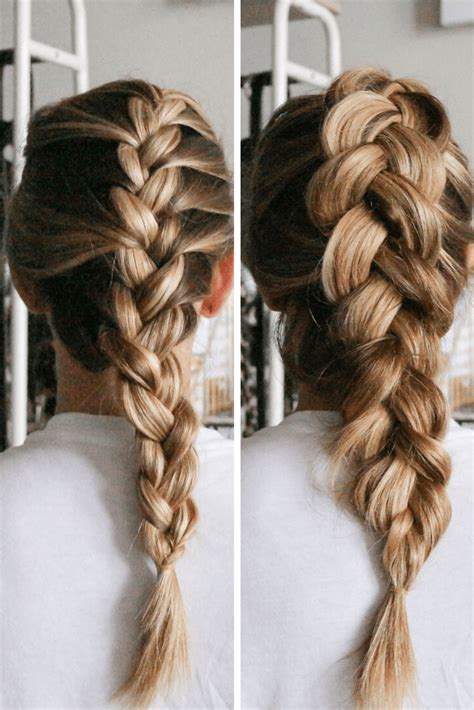Hairstyling has evolved throughout history, giving rise to countless braiding techniques that have stood the test of time. Among the most popular and versatile are the French braid and Dutch braid, two iconic styles that have adorned heads for centuries. This comprehensive guide will delve into the intricacies of these two braiding methods, comparing and contrasting their techniques, aesthetic appeal, and suitability for different hair types.

Understanding French and Dutch Braiding
French Braid:
A French braid, also known as a “classic braid,” is a type of three-strand braid that incorporates new hair from the sides as it is woven down the length of the hair. It creates a flat, elegant appearance that is often seen in both casual and formal settings.
Dutch Braid:
A Dutch braid, also known as a “reverse French braid” or “inside-out braid,” is similar to a French braid in its three-strand structure. However, the main difference lies in the direction of the strands: instead of weaving the side strands over the center strand, as in a French braid, the Dutch braid weaves them under. This results in a slightly raised, intricate appearance.
Key Differences
| Feature | French Braid | Dutch Braid |
|---|---|---|
| Strand direction | Weaves side strands over the center | Weaves side strands under the center |
| Appearance | Flat, elegant | Raised, intricate |
| Difficulty | Moderate | Challenging |
| Suitable hair types | All hair types | Thick, coarse hair |
Benefits of French vs. Dutch Braids
French Braid Benefits:
- Timeless and elegant style
- Easy to learn and master
- Wide range of variations (e.g., headband braids, side braids)
- Secure and holds hair in place
Dutch Braid Benefits:
- Edgy and eye-catching appearance
- Adds volume and texture to fine or thin hair
- Creates a more substantial and intricate braid
- Ideal for holding back overgrown hair
How to Choose Between French and Dutch Braids
The best choice between a French braid and a Dutch braid depends on the desired aesthetic and hair texture.
- French braids are more versatile and suitable for all hair types, including thin or fine hair. They provide a classic, elegant touch to any outfit.
- Dutch braids are better suited for thicker or coarser hair and add volume and texture. They are ideal for creating bolder, more dramatic hairstyles.
Step-by-Step Braiding Instructions
French Braid:
- Divide your hair into three equal sections.
- Cross the right strand over the center strand.
- Bring the left strand over the new center strand.
- Repeat steps 2-3, adding small sections of hair from the sides as you go.
- Continue braiding until you reach the nape of your neck.
- Secure the end with an elastic band.
Dutch Braid:
- Divide your hair into three equal sections.
- Cross the left strand under the center strand.
- Bring the right strand under the new center strand.
- Repeat steps 2-3, adding small sections of hair from the sides as you go.
- Continue braiding until you reach the desired length.
- Secure the end with an elastic band.
Tips and Tricks
- To make braiding easier, use a detangling brush to remove any knots or tangles before starting.
- For a secure and longer-lasting braid, apply a small amount of hairspray or mousse before braiding.
- If you want a tighter braid, pull the strands firmly as you weave them.
- To create a more voluminous braid, loosen the strands slightly as you weave them.
- Experiment with different variations, such as side braids, crown braids, or fishtail braids, to add some flair to your hairstyle.
Applications and Inspirations
French and Dutch braids are not only timeless but also versatile, with applications in various settings.
Daily Wear:
- Both French and Dutch braids are perfect for everyday wear, providing a quick and easy way to manage and style hair.
- French braids are ideal for casual outings, while Dutch braids add a touch of edginess to everyday looks.
Formal Events:
- French braids can add an elegant touch to formal hairstyles, creating intricate updos and chignons.
- Dutch braids can be used to create bold and dramatic braids for special occasions.
Sports and Activities:
- French and Dutch braids are practical and secure hairstyles for athletes and individuals engaged in physical activities.
- They keep hair out of the way and prevent tangles during workouts or other strenuous activities.
Conclusion
Whether you prefer the classic elegance of a French braid or the intricate texture of a Dutch braid, both techniques offer a timeless and versatile way to enhance your hairstyle. By understanding the key differences between these braiding methods and mastering the techniques, you can create stunning braids that complement your hair type and personal style.
